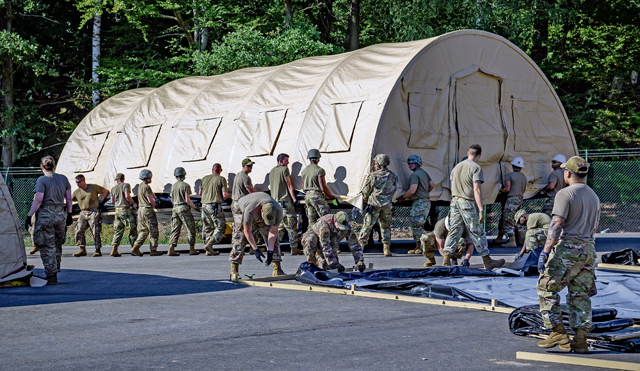
Ramstein’s 70 historic years are an impressive feat — one that would have been impossible without the unit that built it all in the first place. The 435th Construction and Training Squadron has a history just as long and storied as Ramstein itself, yet most people have never heard of it.
The 435th CTS traces its origins to post-war Germany, when a great number of non-German displaced persons that remained in the country needed employment. By the end of 1945, U.S. forces employed over 250,000 individuals in Labor Service Units, which performed services such as maintenance or construction. With Cold War tensions increasing in Europe and the massive manpower needs of the Berlin Airlift, the LSUs were expanded for the first time to include Germans in 1948 and just five years later all USAFE labor units were employing Germans only.
The first iteration of the CTS was born out of these circumstances. Although the Army Corps of Engineers was responsible for overseas airfield construction at the time, they were unable to meet the increasing need for air bases on this side of the Rhine.
On September 8, 1950, the 7329th Labor Service Unit Engineer Construction was created at Rhein-Main Air Base in Frankfurt. The unit was initially assigned to an engineering battalion and even today the CTS’s emblem still bears a U.S. Army Corps of Engineers castle. The all-German members of the unit were housed, clothed, and fed by the U.S. forces and even gained access to toiletry items that were often a luxury in post-war Germany.
These LSUs were not military units, yet all their members had to undergo a three-month basic training course that taught subjects similar to those of a military training camp. After completion they received additional training on heavy equipment and vehicles. The 7329th was specifically used for construction, repair, and maintenance activities within USAFE, becoming the only unit of its kind in the Air Force at the time. In 1952, the unit was tasked with their first big project — building a new air base at Landstuhl.
Initially only on temporary duty at Landstuhl, the workers slept in tents with few amenities and returned to Rhein-Main every weekend. After a year, the move to Landstuhl became permanent and the workers’ accommodations improved to include barracks, a club, and a proper mess hall. The unit used heavy equipment to turn the marshy landscape into two bases — Landstuhl (with the runways) and Ramstein (the administrative side). Due to the marshy conditions, to build the taxiways the workers often had to dig six to eight feet deep and backfill with the red sandstone so common in the area.
In the years that followed, the unit worked on the construction of many military bases in the region, including Spangdahlem, Bitburg, and Sembach. In May 1971, an aircraft barrier, generator and training unit from Wiesbaden transferred to the then-USAFE Civilian Service Unit. This now made the unit a military component, with an active duty commander. It was officially activated and designated as the 7002d Civil Engineering Flight. Its current nickname, “the Deuce,” stems from this original designation. The 7002d was responsible for building streets, runways, clinics, parking lots, hangars, and schools. It also trained Air Force members in construction, firefighting, and rescue techniques. In 2006, USAFE approved the squadron’s humanitarian mission, allowing them to provide humanitarian and civic assistance, prefab construction experts, and airfield evaluations.
In 2009, under the massive reorganization at Ramstein that created the 435 Air Ground Operations Wing, the unit was redesignated the 435 Construction and Training Squadron and assigned to the 435 CRG. Today, it is the only unit of its kind left in the Air Force and still employs nearly 200 local nationals.


